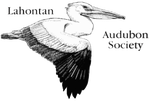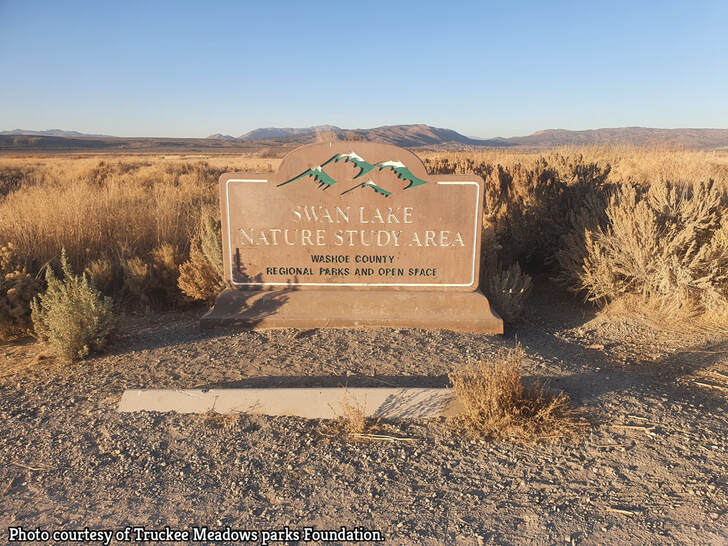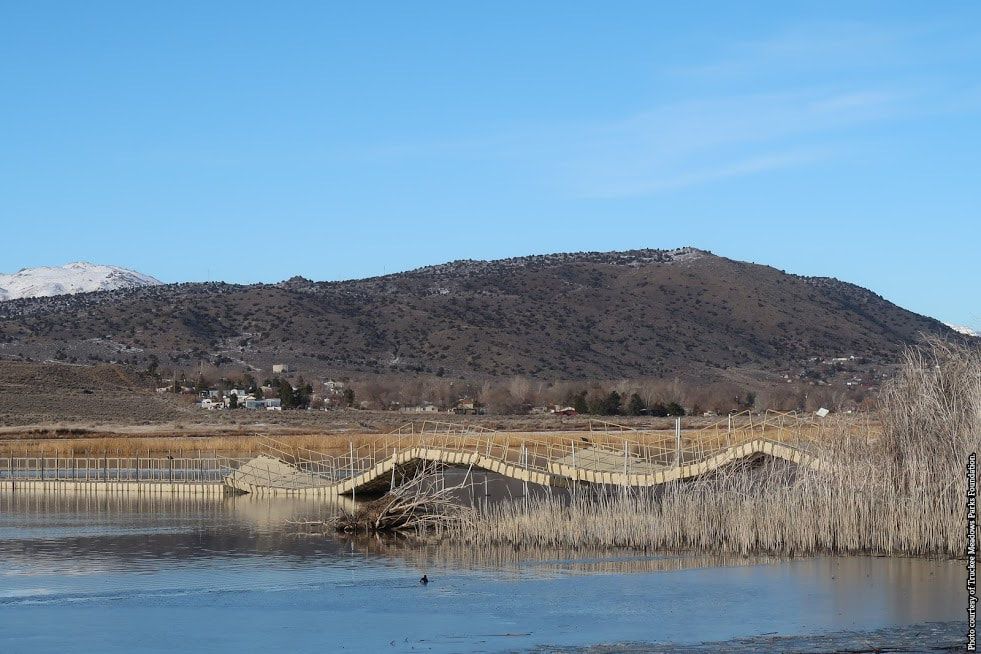|
By David Jickling If you have visited the Swan Lake Nature Study Area over the past couple of years you have probably seen what appears to be a neglected and forgotten park. The boardwalk is completely unusable, walking paths and trails are overgrown and long forgotten, and the park itself seems to be threatened by adjacent development. And yet as a birding location it remains a favorite for many of us who enjoy seeing the pelicans, swans, stilts and avocets, along with numerous other species of waterfowl and shorebirds that depend on the expansive lake and wetlands for food, shelter and nesting habitat. So, what is the status of the park and how did we get here? To answer those questions, we turned to two of the most knowledgeable folks, Bob Goodman, and Colleen Wallace Barnum. Many of you know Bob from his stunning wildlife photography and decades of advocacy on behalf of the Lemmon Valley marsh. Colleen is the Park Operations Superintendent for Washoe County’s Community Services Department and has the difficult job of managing and maintaining more than 49 parks with budgets that haven’t recovered from the Economic Recession of 2009. But first a little background. Swan Lake Nature Study Area (SLNSA) is a functional wetland system in Lemmon Valley located about 14 miles northeast of downtown Reno. This historic wetland is a nesting and migratory bird stopover for more than 150 species of birds. Over the past several decades Lemmon Valley has undergone substantial commercial and residential development, and even more is planned in the foreseeable future. We are fortunate that timely action by a number of dedicated individuals (See Bob Goodman's article below) and organizations over the years helped preserve the wetland/playa as a wildlife sanctuary. A Lemmon Valley Marsh Advisory Board was created to coordinate the preservation efforts with the Lahontan Audubon Society (LAS) having a significant role. These efforts ultimately resulted in the establishment of the SLNSA. The Lemmon Valley drainage encompasses nearly 40 square miles and Swan Lake is the result of seasonal runoff in the valley. Large snow and rain events can inundate Swan Lake for months, even years at a time, causing it to grow to as much as 1,000 acres and then shrink to as little as a few hundred or even drying up completely during droughts. In 2017, Swan Lake swelled to historic levels, flooding dozens of adjacent homes with above normal precipitation which continued through 2019. To better understand Washoe County’s response to this disaster, we asked Colleen Wallace Barnum how Parks managed the problems at SLNSA. Colleen confirmed that the new high-water mark set in 2017 flooded or damaged many of the park’s amenities including the boardwalk, outdoor classroom, trails, signage, kiosks, and benches. Concerned citizens contacted Washoe County parks in early 2017 and efforts by park staff and dedicated volunteers Mike Stone and Brett Russ, were made to heighten the existing boardwalk pilings with pipe extensions. Washoe County applied for FEMA funding hoping to repair the trail system and sections of the boardwalk that were cracked. The FEMA project was approved, and Aspen Developers were hired in 2018 to perform the construction. Several of the trails on the west side of the lake are on Nevada Military property. Although identified as needing repair, they were still under water when work began and therefore have not been repaired. The main trail that leads from the parking lot to the docks was repaired in addition to the trail that leads from the parking lot to the outdoor classroom. The small section of trail that leads from the classroom to the small bridge was not repaired as it was also still under water. Four new sections of dock were installed to replace those that were cracked and damaged. Unfortunately, in October 2019, sustained high-water levels along with heavy wind and wave action battered and twisted the boardwalk rendering it unsafe for use and potentially beyond repair. In response to numerous concerns and questions from LAS members and others about the condition of the boardwalk, encroaching development, maintenance and plans for the SLNSA, Colleen and the Washoe County Parks staff resurrected the Swan Lake Advisory Board which has begun meeting again this past year. The organizations involved include: Washoe County, City of Reno, Nevada Department of Wildlife, Washoe County School District, Nevada National Guard, Bureau of Land Management, LAS and Nevada Land Trust. This group hopes to update the master plan and address continued improvements for the park. Meanwhile, efforts to manage water levels and maintain the park continue. Last fall the drainage ditch (actually Horse Creek) which flows into the lake alongside the access road to the parking was revitalized by removing the overgrown cattails and debris. Although the work was unsightly, it has restored critical flow and the cattails will grow back. The entire area was re-seeded in the hopes that native vegetation would take root. In addition, goats were brought in during the spring of 2021 to remove some of the invasive tall whitetop (Perennial Pepperweed). Washoe County’s Natural Resource Planner Joanne Lowden plans to bring the goats back in the spring of 2022 and hopes to do both a spring and fall weed treatment each year. So what’s next for the Swan Lake Nature Study Area? Tell us your thoughts so that we can share them with the advisory committee. All of us at LAS hope that the nature study area can be improved for both visitors and wildlife. The SLNSA provides us with a unique opportunity as an educational field laboratory as well as a place of quiet recreation for all. A Thirty Year Journey to Today's Swan Lake NSA By Bob Goodman At the time in the early 1990's, it may have seemed a bit unnecessary to be concerned with coming changes to Lemmon Valley, its biological sewer treatment plant, and what locals referred to as the Sewer Pond. But, thirty years later, in the year 2021, it is obvious that the concern was not too early or unnecessary. The concept of the Sewer Pond becoming the Swan Lake Nature Study Area thirty years ago became a reality in April, 1999, when then-Senator Richard Bryan read the proclamation along the shore so declaring it to forever be so. The journey from 1991 to 1999 is a textbook example of diverse local, state, federal agencies, local organizations, and individuals successfully joining for a common goal. This was accomplished through the formation of the Swan Lake Advisory Committee comprised of representatives from the above groups. The Committee took on many functions, such as identifying private lands within the public holdings and through many different means acquiring these lands for the public good. Drawing up a management plan that would provide public access for all, outdoor education for both schools and adults, stressing the importance of wetlands to our everyday lives. Also, planning for and providing physical facilities for the public good. The number of people that helped the Committee reach the goal of dedication is many, with only a few notable ones mentioned here as Ken Pulver, president of LAS at the inception, Loren Brazelle, with the Nevada Military, a major land holder of the NSA, the representative of the Bureau of Land Management, another major land holder, and Bill Gardner, planner and designer with Washoe County Parks. The contributions of these groups continue up through today. Thirty years ago, no one dreamed of the changes we have seen around Swan Lake. It has been quite a journey from sewer pond to nature study area, of which many, many folks can have a deserved sense of pride and accomplishment. In the beginning, we had to walk cross country to reach the shore of Swan Lake. We had to beware of quicksand around the springs feeding the lake along the southwest shore, which are no longer running due to being intercepted by development. The committee's working name for the area was Lemmon Valley Marsh and Playa, which changed to Swan Lake when a Peavine mining district map of 1895 showed Swan Lake, Silver Lake, and White Lake. Although urbanization has risen around the waters of Swan Lake, a visitor can still feel a sense of solitude and peace while within its thriving natural world. |
topics
All
Archives
July 2024
|




 RSS Feed
RSS Feed